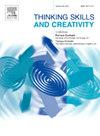Large language models show both individual and collective creativity comparable to humans
IF 3.7
2区 教育学
Q1 Social Sciences
引用次数: 0
Abstract
Artificial intelligence, especially large language models (LLMs) are increasingly adopted in the workplace, which has significant implications for the future of work if they show creativity comparable to humans. To measure the creativity of LLMs holistically, the current study uses thirteen creative tasks spanning three domains. We benchmark the LLMs against individual humans, and also take a novel approach by comparing them to the collective creativity of groups of humans. We find that the best LLMs (Claude and GPT-4) rank in the 52nd percentile against humans, and overall LLMs excel in divergent thinking and problem solving but lag in creative writing. We also show that the collective creativity in 10 LLM responses is equivalent to 8–10 humans. When there are more than 10 LLM responses, in terms of incremental collective creativity, two additional LLM responses equal one extra human. Ultimately, LLMs, when optimally applied, may compete with a small group of humans in the future of work.
大型语言模型显示出与人类相当的个人和集体创造力
人工智能,尤其是大型语言模型(llm)越来越多地应用于工作场所,如果它们表现出与人类相当的创造力,这将对未来的工作产生重大影响。为了从整体上衡量法学硕士的创造力,本研究使用了跨越三个领域的13个创造性任务。我们将法学硕士与人类个体进行比较,并采用一种新颖的方法,将它们与人类群体的集体创造力进行比较。我们发现,最好的法学硕士(Claude和GPT-4)与人类相比排名在第52百分位,总体而言,法学硕士在发散思维和解决问题方面表现出色,但在创意写作方面落后。我们还表明,10个LLM反应的集体创造力相当于8-10个人。当有超过10个法学硕士回应时,就增量集体创造力而言,两个额外的法学硕士回应等于一个额外的人。最终,法学硕士,当最佳应用,可能与一小群人在未来的工作竞争。
本文章由计算机程序翻译,如有差异,请以英文原文为准。
求助全文
约1分钟内获得全文
求助全文
来源期刊

Thinking Skills and Creativity
EDUCATION & EDUCATIONAL RESEARCH-
CiteScore
6.40
自引率
16.20%
发文量
172
审稿时长
76 days
期刊介绍:
Thinking Skills and Creativity is a new journal providing a peer-reviewed forum for communication and debate for the community of researchers interested in teaching for thinking and creativity. Papers may represent a variety of theoretical perspectives and methodological approaches and may relate to any age level in a diversity of settings: formal and informal, education and work-based.
 求助内容:
求助内容: 应助结果提醒方式:
应助结果提醒方式:


